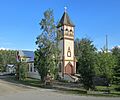List of National Historic Sites of Canada in Yukon facts for kids
This is a list of important places called National Historic Sites in the Yukon Territory. There are 12 of these special sites in Yukon. Five of them are part of Canada's national park system and are looked after by Parks Canada. You can spot these sites by the little beaver icon next to their name ![]() .
.
Canada also remembers important events and people from history. These are marked with similar plaques, but they are not always National Historic Sites. This list uses the official names given by the Historic Sites and Monuments Board of Canada. These names might be different from other names you hear for these places.
* Tr'ondëk-Klondike World Heritage Site unit
Contents
Exploring Yukon's Historic Sites
What are National Historic Sites?
National Historic Sites are places that tell important stories about Canada's past. They help us understand how people lived and what happened long ago. In Yukon, these sites often relate to the exciting Klondike Gold Rush and the early days of the territory.
Discovering Dawson City's History
Many of Yukon's historic sites are found in Dawson City. This town was a very busy place during the gold rush.
Canadian Bank of Commerce
The Canadian Bank of Commerce building was finished in 1901. It is a beautiful old building with fancy metal decorations. This bank was very important during the Klondike Gold Rush. It helped people manage their money when gold was discovered.
Dawson Historical Complex
The Dawson Historical Complex is the old part of Dawson City. It became a historic site in 1959. This area shows what a frontier town was like during the gold rush. You can see many old buildings that tell the story of Dawson City's early days. It also shows how isolated the town was and its strong connection to gold mining.
Former Territorial Court House
The Former Territorial Court House was built in 1901. It replaced an older log courthouse. This building showed that the Canadian government wanted to keep law and order in Dawson City. It was a symbol of justice in the wild north.
Old Territorial Administration Building
The Old Territorial Administration Building was also completed in 1901. This building was the main office for the new Yukon Territory's government. It represents how the Yukon, "north of sixty," became connected to the rest of Canada.
S.S. Keno Steamboat
The S.S. Keno is a large, old steamboat launched in 1922. It sits on the bank of the Yukon River in Dawson City. This type of boat, called a sternwheeler, was very common for travel and moving goods on Yukon's rivers and lakes. It shows how people traveled and traded in the past.
St. Paul's Anglican Church
St. Paul's Anglican Church was finished in 1902. It is a great example of a church built in a frontier area of Canada. It has simple designs with elements from the Gothic Revival and Arts and Crafts styles. It tells us about the early missions in the region.
Yukon Hotel
The Yukon Hotel was built in 1898. It is a small wooden building with a false front. This style was very common for businesses during the busiest time of the Klondike Gold Rush. It gives us a peek into what commercial buildings looked like back then.
Gold Rush Discoveries and Mining History
The gold rush shaped much of Yukon's history. These sites show how gold was found and mined.
Discovery Claim (Claim 37903)
The Discovery Claim (Claim 37903) is a mining spot on Bonanza Creek. This is where the Klondike Gold Rush officially began in 1896. Finding gold here started the huge development of the Yukon Territory.
Dredge No. 4
Dredge No. 4 is a giant machine used to dig for gold. It was finished in 1913 and moved to Bonanza Creek in 1941. This preserved machine shows how important large-scale dredging was for finding gold in the Klondike region. It represents a big step in gold mining technology.
Important Transportation and Indigenous Sites
Not all sites are about gold. Some tell stories of travel and the lives of Indigenous peoples.
S.S. Klondike Steamboat
The S.S. Klondike is another large paddle steamer. It was launched in 1937 and is now dry-docked in Whitehorse. This boat was the biggest and last of the commercial steamboats used in the Yukon. It highlights the importance of river travel for trade and transport.
T'äw Tà'är Cultural Landscape
T'äw Tà'är is a 14.6-hectare site where the Teslin River meets Hutamya Chù creek. It became a historic site in 2012. This area is a special cultural landscape for the Southern Tutchone people of Ta’an Kwäch’än. It was used for gathering food, traveling, and trading for many years.
Tr'ochëk Indigenous Site
Tr'ochëk is located at the meeting point of the Yukon and Klondike Rivers near Dawson City. This site contains the remains of fish camps used by the Hän. It also includes areas where they traditionally gathered plants and lookout points. It tells us about the long history of Indigenous life in the region.
See also
Images for kids








